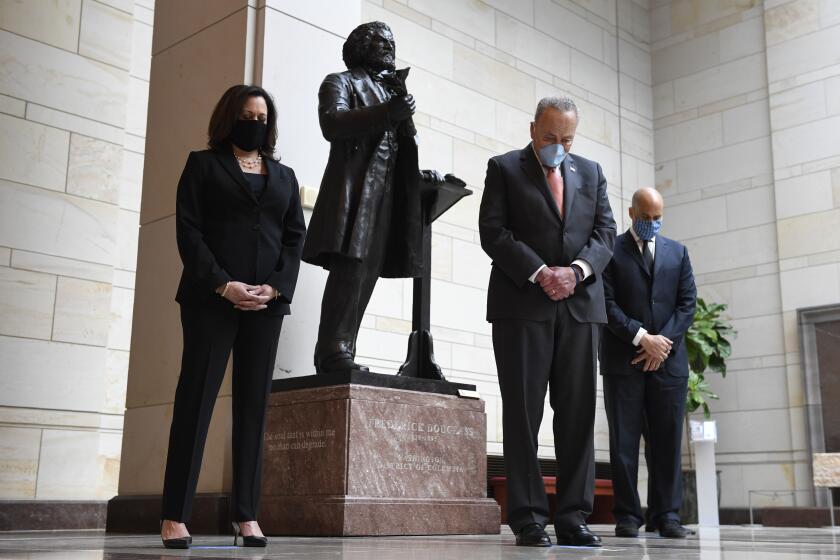Justices Sharply Limit Emotional Distress Suits
The state Supreme Court sharply limited emotional distress suits Thursday, ruling over a harsh dissent that a mother who did not actually see her child hit by a car cannot collect money damages.
The court by a 5-2 vote said direct family members can collect damages for emotional distress only if they actually witness an injury-producing event and suffer emotional distress “beyond that which would be anticipated in a disinterested witness.”
Writing for the majority in a closely watched case, Justice David N. Eagleson said he was seeking to draw a clear line to govern emotional distress suits in the future and avoid “limitless liability out of all proportion to the degree of the defendant’s negligence.”
Eagleson reasoned that if the court had opted to allow emotional distress claims by family members who do not witness accidents, insurance companies would be unable to issue insurance policies without “imposing unacceptable costs” on their policyholders.
“That relatives will have severe emotional distress is an unavoidable aspect of the human condition,” Eagleson said. He was joined by the court’s four other conservative members.
“The emotional distress for which monetary damages may be recovered, however, ought not to be that form of acute emotional distress or the transient emotional reaction to the occasional gruesome or horrible incident to which every person may potentially be exposed in an industrial and sometimes violent society.”
The court went on to emphasize that unrelated friends or unmarried partners may not collect for emotional distress--”regardless of the depth of feeling or the resultant physical or mental illness that results from witnessing violent events.”
Dissenting Justice Allen E. Broussard called the ruling “myopic,” and said it “will deny recovery to victims whose injuries from the negligent acts of others are very real.”
‘Arbitrary Standard’
Broussard said the majority’s “arbitrary standard” will “lead to unjust results.” Under the new rule, Broussard said, a mother could not sue even if she saw “her 6-year-old son immediately after he was electrocuted, lying in a puddle of water in a dying state, gagging and choking.”
The decision overturned a Court of Appeal ruling in a San Diego case that would have allowed the mother, Maria E. Thing, to sue for emotional distress. She had been in her Lemon Grove home in December, 1980, when her daughter ran inside to say a car had run over her son, John.
Thing rushed outside to find her son bleeding and unconscious. She thought he was dead. A Superior Court in San Diego dismissed the suit, finding that since she did not actually see the accident, she could not sue.
The boy suffered a head injury and collected about $100,000 in a separate action against the motorist and his insurance company, according to the family’s lawyer, Patrick F. O’Connor of El Cajon.
“This ruling restricts access to the courts for people who undeniably suffered harm from someone else’s wrongdoing,” O’Connor said.
Marcelle E. Mihalla, the San Diego lawyer who represented motorist James V. La Chusa on behalf of the Automobile Club of Southern California, hailed the ruling, saying that “once you allow a plaintiff who wasn’t at the scene to collect . . . the floodgate is opened.”
“You have to have reasonable limits to liability,” she said.
The case drew friend-of-the-court briefs from insurance companies that urged the tighter standard enunciated by the court on Thursday. The California Trial Lawyers Assn. argued for a looser standard.
“The fear of a flood of lawsuits and claims of increased insurance rates has never been demonstrated to be true,” said Douglas deVries, who wrote the trial lawyers’ brief.
“It’s best left to a jury to decide whether the event really happened and the person really suffered the injury,” DeVries said, adding that the ruling suggests that the court has a “distrust” of letting juries decide such issues.
In the opinion, Eagleson criticized a landmark 1968 California Supreme Court ruling that allowed emotional distress suits by family members who saw, heard or in some other manner sensed an accident. It was the first ruling by a high court anywhere in the country that allowed such suits.
Eagleson said the 1968 case, “like a pebble cast into the pond,” created a proliferation of lawsuits and “ever-widening circles of liability” because of its “murky” standards.
He went on to attack several emotional-distress opinions issued since the 1968 case as evidence of the “expansive progression” of court decisions allowing emotional distress suits.
Cases Allowed to Proceed
In one case, a suit was allowed to proceed after a family member was told the circumstances of an accident. In another, a mother was allowed to sue because she may have mentally reconstructed the accident.
Eagleson, citing confusion in the lower courts, said the high court was under an “obligation to create a clear rule under which liability may be determined.”
“In doing so, we balance the impact of arbitrary lines which deny recovery to some victims whose injury is very real against that of imposing liability out of proportion to culpability for negligent acts,” he said.
However, in a dissent, Justice Stanley Mosk attacked the majority for “callous disregard” of rulings by the high court and courts of appeal, “some prevailing for three decades.”
More to Read
Get the L.A. Times Politics newsletter
Deeply reported insights into legislation, politics and policy from Sacramento, Washington and beyond. In your inbox three times per week.
You may occasionally receive promotional content from the Los Angeles Times.










